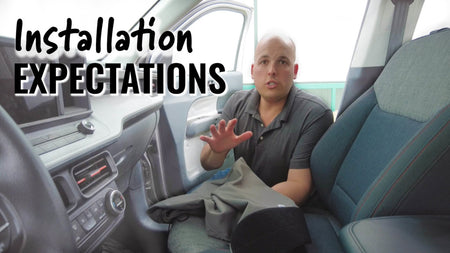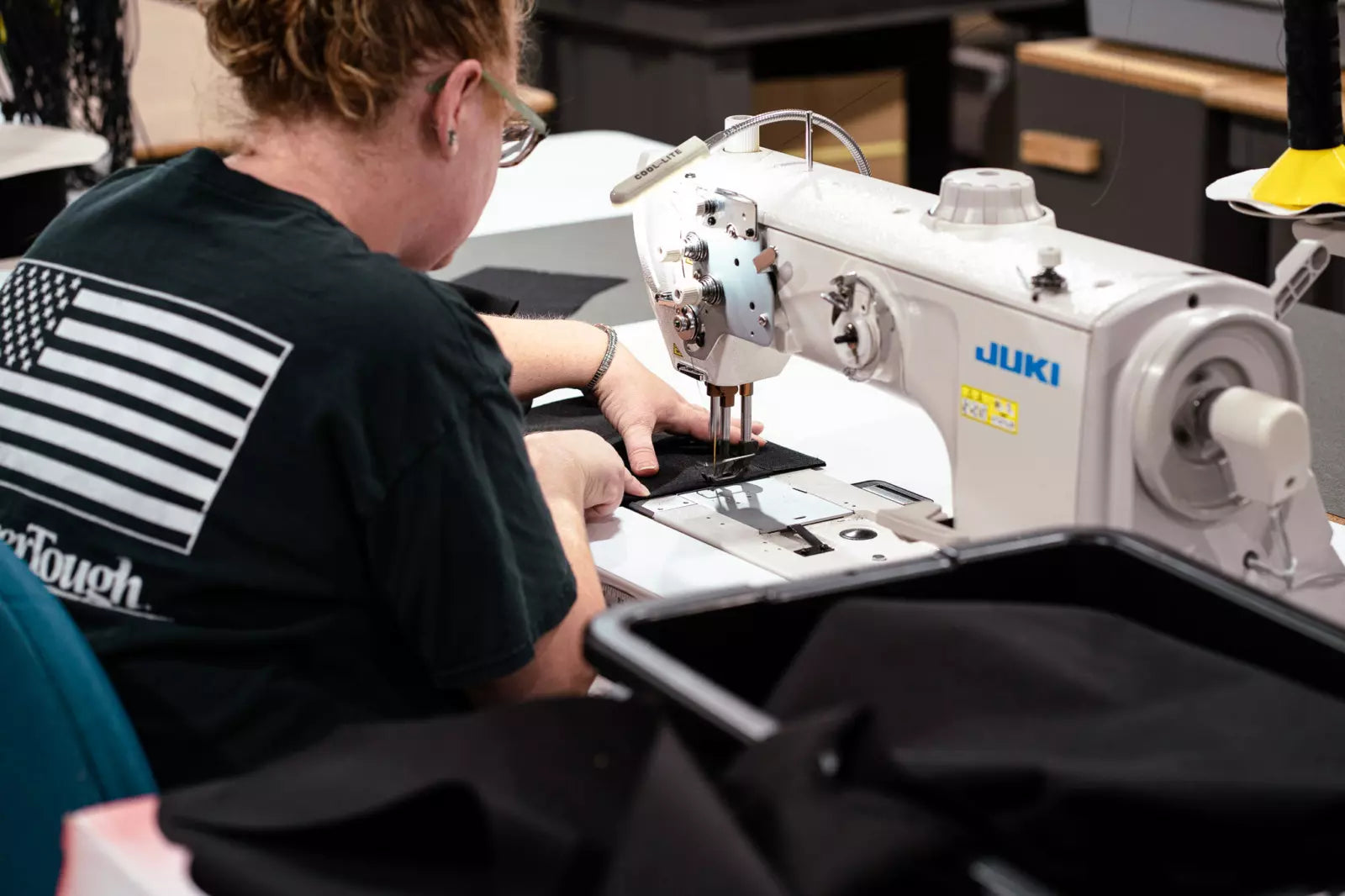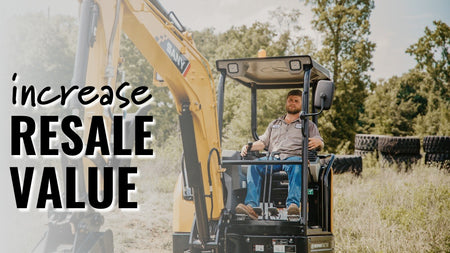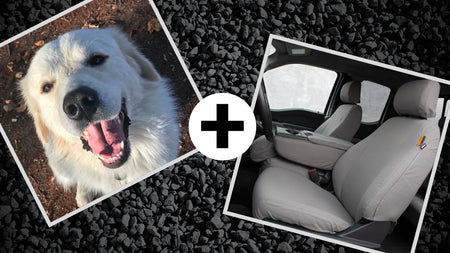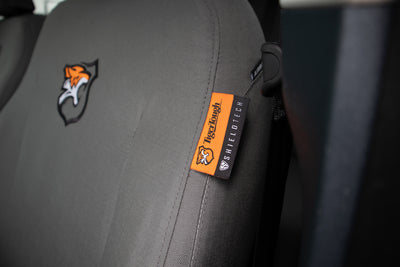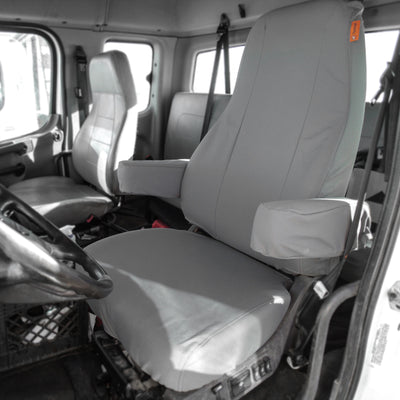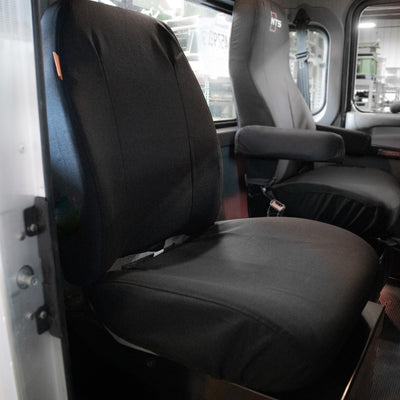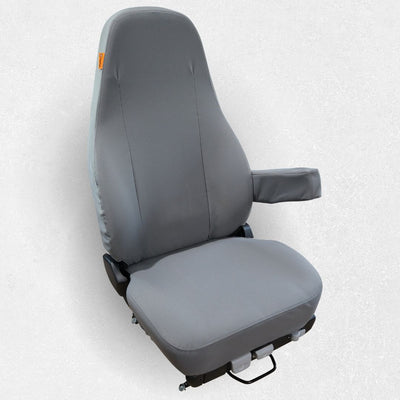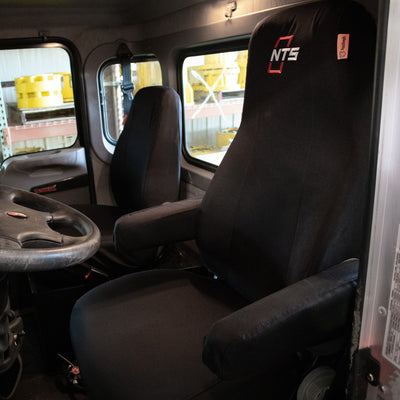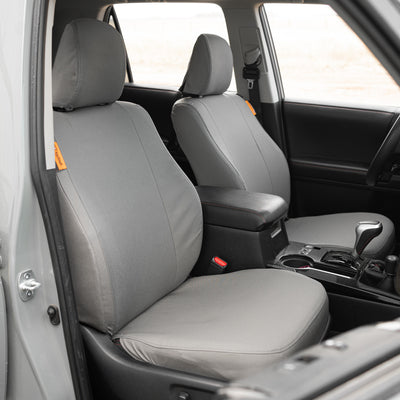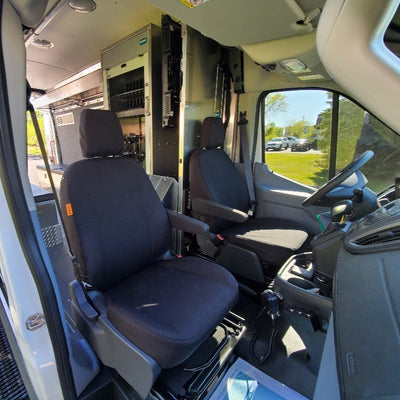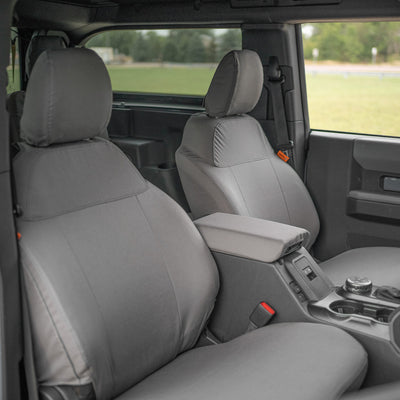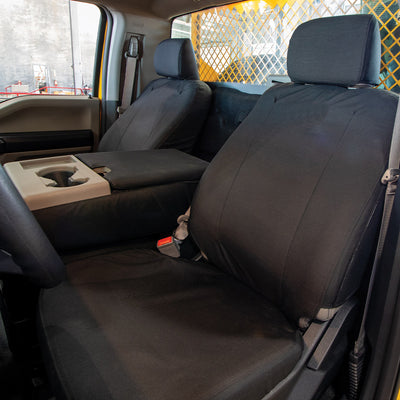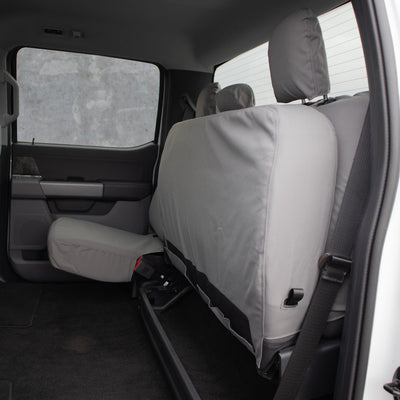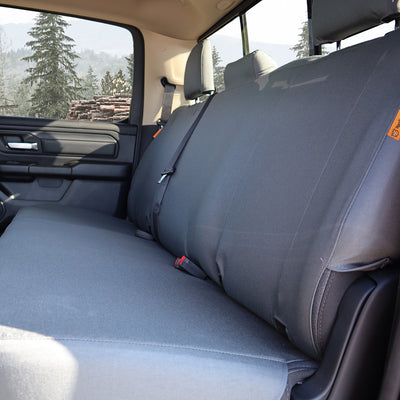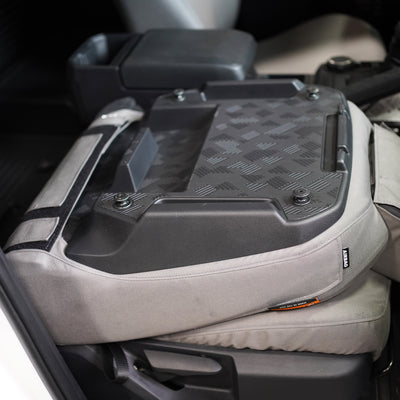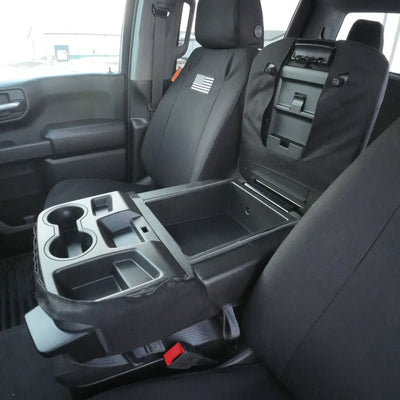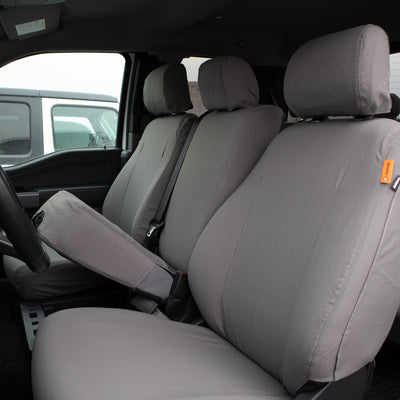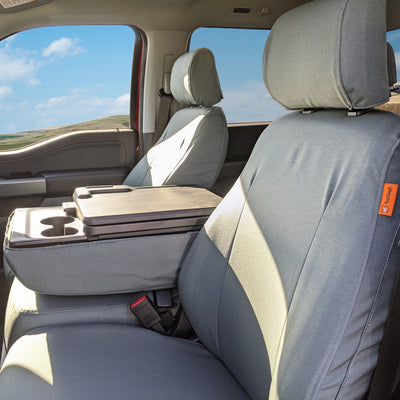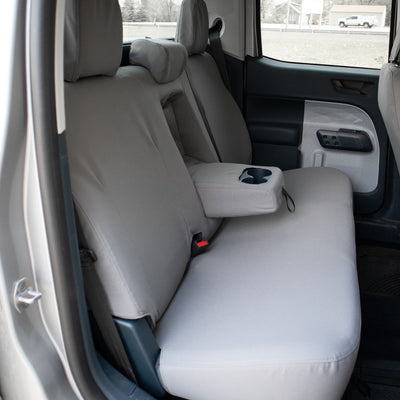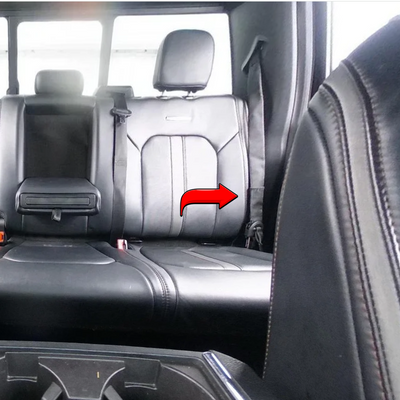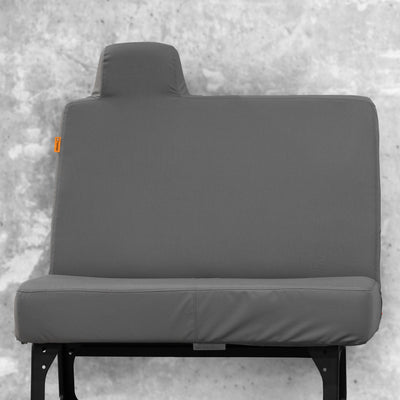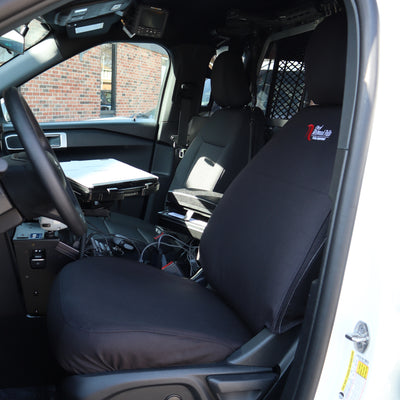Choosing the right car seat cover material isn’t just about style—it's about comfort, durability, and maintenance. Whether commuting daily, tackling tough jobs, or cruising on the weekend, the material you choose affects your experience.
We'll closely examine materials like the tough-as-nails CORDURA®, the tried-and-true duck cotton, and the versatile neoprene. Each of these has its own set of strengths tailored for the hardworking vehicle owner. We'll also tackle why some popular choices like pleather, faux leather, leather, and suede might not cut it for everyone. Join us as we break down the pros and cons of each material, arming you with the knowledge you need to outfit your ride for the demands of everyday life.
CORDURA®: Tough, Trustworthy, and Tailored for Your Truck
Pros
- Made in America: One of the standout features of CORDURA® is its American heritage. Manufactured with rigorous quality control standards, CORDURA® offers reliability that you can trust.
- Breathable: For those long drives or hot summer days, breathability is key for comfort. CORDURA®'s breathable fabric ensures that air circulates well, preventing you from the discomfort of sticking to your seat, making it an excellent choice for warmer climates and heated and cooled seats.
- Durable: If toughness is a top priority, CORDURA® is hard to beat. It resists abrasions, tears, and scuffs; CORDURA® fabric is built to last. Whether you’re hauling tools, pets, or just about anything else, these seat covers won’t easily give in to wear and tear. This stuff is nearly indestructible, which is why we do torture tests on it.
Cons
- Not the Softest: With great durability comes a slightly less soft texture, something similar to a backpack material. While CORDURA® excels in many areas, it may not provide the plush comfort that some users prefer, especially those looking for a cushiony feel. It’s more about practicality and less about luxury, making it ideal for those who value longevity and performance over softness.
Duck Cotton: Comfortable, Breathable, Yet Less Durable
Pros
- Breathable and Comfortable: Duck cotton is highly prized for its comfort and breathability, making it an ideal choice for those who prioritize a pleasant seating experience. You might recognize this as Carhartt’s signature material. The fabric's natural fibers allow air to circulate freely, reducing sweat and sticking during long drives or in warm weather.
Cons
-
Not
Waterproof:
While duck cotton scores high on comfort, it falls short in its resistance to water and spills. Duck cotton
might not be the best choice if you often have drinks in the car or transport
pets
and kids. Its absorbent nature can lead to moisture seeping into the seats, potentially causing stains and
even mildew if not addressed quickly.
- You can spray the material with a waterproofing barrier, but do this on a day when you can keep the windows open for a few hours–otherwise, you’ll be ridin’ high on those fumes.
- Also, check to see if the seat covers you’re considering have already been treated to be water repellent.
- Durability Concerns: Despite its many benefits, duck cotton does not always stand up well to the test of time, especially under rough conditions. It may not withstand rigorous durability tests, and some synthetic fabrics or more rugged materials like CORDURA® may not. This can be a significant drawback for those who use their vehicles heavily or in harsh environments, as the material might wear out faster than expected.
Neoprene: Flexible, Comfortable, but Moisture-Retentive
Pros
- Flexible and Comfortable: Neoprene is flexible, making it an excellent choice for seat covers. This material conforms closely to the shape of your seats (just like a wetsuit hugs your body), providing a snug fit without bunching or sliding. Its cushiony feel enhances the driving experience, especially during long hauls or frequent commutes.
- Protects the Seat: Neoprene is exceptional at protecting your seats from liquids and other common spillable substances. It acts as a barrier, preventing spills from seeping through to the upholstery beneath, which helps maintain the integrity and appearance of your car’s interior.
Cons
- Holds Liquids: While neoprene does a great job at preventing spills from reaching the seat, it does tend to hold onto moisture. This characteristic can result in a damp feeling on the surface, which might be uncomfortable for some users, especially in humid climates or during hot weather.
- Temperature Sensitivity: Given its insulating properties, neoprene might not be the best choice in very hot climates as it can contribute to a warmer seating experience. It might inhibit the effectiveness of built-in cooling features in some high-end car seats, which could be a drawback for drivers relying on these features during summer.
Sheepskin: Ultimate Comfort with a Luxe Feel
Pros
- Supreme Comfort: Sheepskin seat covers are the epitome of comfort. The soft, plush material provides a luxurious feel that enhances every driving experience, making even the longest drives enjoyable.
- Excellent Insulation: Known for its natural insulating properties, sheepskin maintains a comfortable temperature in all climates. It keeps you warm during the cold winter months by trapping body heat and cool in the summer by allowing air to circulate and reduce sweat.
- Durability: Despite its softness, sheepskin is remarkably durable. With proper care, these seat covers can last for years, making them a worthwhile investment for those looking for long-lasting quality.
Cons
- High Cost: All this comfort and luxury come at a price. Sheepskin is generally more expensive than other materials used for seat covers, which might not be ideal for budget-conscious buyers.
- Care Requirements: Maintaining sheepskin covers involves more than just a simple wipe-down. They require specific cleaning methods to preserve their look and feel. Regular brushing and special cleaning agents are recommended to handle stains and maintain the fleece’s natural oils.
Microfiber: Affordable Comfort with Style Flexibility
Pros
- Soft and Comfortable: Microfiber seat covers are soft, providing a comfortable seating experience that enhances the feel of your car’s interior.
- Versatile Design Options: Available in many colors and patterns, microfiber allows you to customize the look of your car or truck to suit your style without breaking the bank.
- Ease of Cleaning: Unlike more delicate materials, microfiber is relatively easy to maintain. It can be cleaned effectively with simple techniques and is less likely to stain, making it ideal for those who want hassle-free upkeep.
- Cost-Effective: Often priced more affordably than genuine leather, microfiber offers a budget-friendly alternative without sacrificing comfort or looks.
Cons
- Breathability Issues: Microfiber is not as breathable as cotton or CORDURA®, which might be a concern in hotter climates where air circulation is crucial for comfort.
- Odor Retention: Over time, microfiber can absorb and retain odors, which might require more frequent cleaning to maintain a fresh smell inside your vehicle.
- Durability Concerns: Despite its many benefits, microfiber is not as durable as other materials. It may wear out faster, particularly under frequent use or in harsh conditions, which could lead to earlier replacement or repair needs.
Materials Not Recommended
Pleather/Faux Leather
- Pleather and faux leather lack breathability, which can be problematic in warmer climates. Sitting on these materials during hot weather can lead to discomfort (swampa**) and excessive sweating, as air circulation is strangled in the synthetic material.
- In high temperatures, these materials can become sticky and uncomfortable, making them less than ideal for use in vehicles without effective air conditioning.
Leather
- Leather requires regular conditioning to prevent cracking and drying out, which can be a significant commitment.
- They’re also insanely expensive. Many aren’t just covers; they’re a whole new skin on your factory seats. That’s a commitment.
Disclaimer: This could be a good option if you want to replace your interior entirely. It’s just not something we’d classify as a “seat cover” if you’re doing a full upholstery swap.
Suede
- Suede is notoriously challenging to maintain, especially in a car environment where spills and stains are likely. Its delicate nature requires special cleaners and cannot be simply wiped down in the event of spills.
- Unlike more robust materials, suede can wear down relatively quickly with regular use, leading to an unkempt appearance and necessitating frequent replacements or repairs.
Choosing the Right Seat Cover Material for Your Needs
Selecting the perfect seat cover material involves balancing various factors, from comfort and durability to maintenance and cost. In this guide, we've explored several popular materials, each with its advantages and drawbacks.
- CORDURA® offers unmatched durability and breathability, ideal for those who need rugged protection.
- Duck cotton scores high on comfort but may fall short in durability and water resistance (unless it’s been specifically treated for that).
- Neoprene excels in flexibility and water protection, though it retains moisture and may affect temperature control features.
- Sheepskin provides luxurious comfort and excellent insulation but comes with a higher price tag and maintenance demands.
- Microfiber offers a budget-friendly and stylish alternative, but it lacks in breathability and durability.
As you consider your options, consider your vehicle's specific needs and personal preferences. No seat cover is perfect, but whether you prioritize easy maintenance, ultimate comfort, or durability against the elements, there's a seat cover material out there that will work best for you.
| Material | Pros | Cons |
| CORDURA® |
|
|
| Duck Cotton |
|
|
| Neoprene |
|
|
| Sheepskin |
|
|
| Microfiber |
|
|
| Leather |
|
|
| Pleather/Faux Leather |
|
|
| Suede |
|
|



